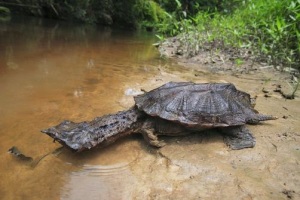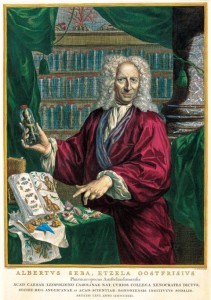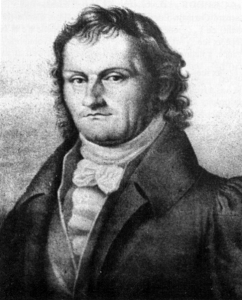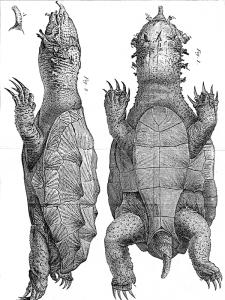One thing I am guessing may be curious is why I a taxonomist and paleontologist, both hard sciences, would be interested in nomenclature. Part of it is of course me and my own interests. It is fair to say that if I had not become a scientist I could easily see myself doing literature I like writing and enjoy books, particularly antique books. I also see it as an important component when studying taxonomy, after all once I determine through scientific methods that a population is a species I do have to decide what it should be called, and sometimes it already has a name, lost and forgotten in synonymy. Unlike much of science where we read the latest findings and older studies are made somewhat redundant by recent advances, the so called cutting edge, nomenclature is the exact opposite with nomenclature we have to start at the beginning.
The ICZN rules determine that the beginning is Linnaeus 1756, the starting point for modern binomial nomenclature. All names prior to that are not available even though Linnaeus copied a number of names from already common usage that go back some even thousands of years, such as Testudo greaca and Chelonia mydas that were used by Aristotle in ancient Greece. In the past I have given historical background for several names here in my discussions of their nomenclatural issues but this time I want to take one further. The Matamata (Chelus fimbriatus) has appeared in the texts of Europe since before Linneaus and hence has pre-Linnaean names and in this post I am going to trace it back as far as I can go to when it first came to the notice of Europe in its Age of Discovery. It seems the Matamata first came to the attention of European explorers around 1730.
In the past I have been told that Albertus Seba (1665-1736) was the first to describe the Matamata in his work “Locupletissimi rerum naturalium thesauri accurata descriptio – Naaukeurige beschryving van het schatryke kabinet der voornaamste seldzaamheden der natuur“ 1734. However on examining it I find only three turtles from Brazil all described as “Testudo terrestris, Brasiliensis” and figured in Plate 80, figures 2, 3 and 6. Do not mistake this as a binomial name, even if it looks like one, that was not the intent it is in Latin and is meant as the “Forma specifica, locality” That is it is a terrestrial turtle from Brazil. By terrestrial he means its not from the ocean. Figure 2 is a Podocnemis expansa, Figure 3 is a Chelonoidis denticulata and Figure 6 seems to be a Podocnemis unifilis. The Latin descriptions of the specimens in the text would support this by their coloration. Although I have not seen the second edition, published after Seba’s death, it would appear he did not describe a Matamata. This is a very bizare looking turtle its a bit hard to miss.
The first time that the species was however described was by Pierre Barrère (1690-1755) in his work “Essai sur l’histoire naturelle de la France équinoxiale, ou Dénombrement des plantes, des animaux et des minéraux qui se trouvent dans l’isle de Cayenne, les isles de Remire, sur les côtes de la mer et dans le continent de la Guyane” 1741:165. This Latin text describes the appearance habits of the Matamata that Barrère obtained on his journeys to Guyana and represents the oldest European description I have been able to determine is a genuine Matamata. For those who download it, please note in a PDF reader the appropriate text is on page 181, though this is 165 of the page numbers. He calls it “Testudo terrestris, major putamine echinato, & striato” basically this is saying it is a terrestrial tortoise with an echinate shell that is striated. Again by terrestrial he means not oceanic.
Of course these names are all pre-Linnaean and hence are not available for nomenclature. In Linnaeus’ 1758 edition of Systema Naturae he does mention a Testudo terrestris also as “Testudo terrestris pusilla Worm mus 313” this is not to be confused it is referring to a junior synonym of the Greek Tortoise (Testudo graeca graeca). As may be becoming apparent, quite a few turtles have been called what is effectively “Land Tortoise” over the last 280 years. The link to Linnaeus offered here is a cut-down version with only the turtles in it.
The next description of the species was actually not a bad one, though as I will explain later it cannot be used for nomenclatural purposes. It was the first to describe the Matamata’s infamous facial structures and appendages. This was by Phillipe Fermin (1720-1790) (sorry I can locate no online biography for this person) in a publication called “Histoire naturelle de la Hollande équinoxiale ou description des animaux, plantes, fruits et autres curiosités naturelles, qui se trouvent dans la colonie de Surinam, avec leurs noms différents, tant françois, que latins, hollandois, indiens et nègre-anglois” (1765:51) it is the oldest post-Linnaean name for the species. It was named “Tortue de Terra, en Latin Testudo terrestris, en Indien Raparapa“. He has technically given it the scientific name of Testudo terrestris here and this could technically be the oldest binomial name for the species. It is also the first time the native American name was published. However at a later date this name was dealt with as I shall explain. In Linneaus 1767 and again in 1788 “Testudo terrestris” is mentioned in various combinations that are not relevant to the Matamata. In 1775 Peter Forsskål described the species that is now known as Testudo graeca terrestris a name that was used for many years as either a species or subspecies. The name gained over time what is seen as stability of usage. Being used for the eastern African form of the Spur Thighed Tortoise or Greek Tortoise. It has therefore become destabilising to recognise that this well used name was in fact a junior Homonym to an unused and forgotten name for the Matamata. In nomenclature a homonym is where two names are spelt exactly the same which is not permitted under the Principal of Homonymy, and normally the senior Homonym takes priority.
In the meantime back in South America another description of the Matamata had occured. Johann Gottlob Schneider (1750-1822) named the species as we know it today, Testudo fimbriata, now of course in a different genus as Chelus fimbriatus. The spelling change is from what is called the Principal of Coordination, where the gender of the genus and the species names must match. This name also gained long term usage and stability. Interestingly Schneider mentions both Barrère and Fermin in his description of the Matamata and personally I am not entirely convinced he ever saw one. For there is no specimen of the species he had access to at the time, hence there is no holotype. It would seem Schneider’s description is basically based on Fermin and Barrère’s descriptions, in fact he copies part of Fermin’s description word for word. However, it is a binomial name and one of the oldest for the species. Another description shortly after Schneider was Johann Friedrich Gmelin (1748-1804) who was continuing Linnaeus’ Systema Naturae, I am not really convinced this is a description he called it Testudo fimbria and immediately seems to credit Schneider, it may be a mistake. Interesting to note however he states that Fermin’s specimen came from Surinam, that Barrère’s is from Guyana but makes no mention of any specimen for Schneider. This one does get listed in synonymies, probably more for safety reasons, ie we cannot be sure.
The next description was interesting because this is where we get the common name of Matamata. Jean-Guillaume Bruguière (1750-1798) in a work “Description d’une nouvelle espèce de tortue de Cayenne. Journal d’Histoire Naturelle, Paris 1(7):253–261.” 1792, describes a new species as Testudo matamata, his specimen was sent to Paris and is in all likelihood that later studied by Georges Cuvier. This specimen is from French Guyana. We still do not have a holotype, but I suspect that if Georges Cuvier’s specimens from his 1825 publications on this species are still in the Muséum National d’Histoire Naturelle, then this may be the type of Chelus matamata and the oldest holotype for any name for the species. As best as I can determine Bruguière was one of the first to publish an illustration of the Mata mata.
At this point Ruiz de Xelva described Testudo bispinosa in 1801 and John Edward Gray described Testudo rapara and Testudo raparara in 1831 and 1844 respectively. These descriptions offered nothing new, no holotypes and are listed in the synonymy because they are available names.
The last description of note was by George Baur (1859-1898) this description is very interesting because it may be the only description of an Amazonian specimen of the Matamata. All the others appear to have been Orinoco, being from Surinam and Guyana. In a paper “An apparently new species of Chelys” published in American Naturalist he described the species Chelys boulengerii. This paper is interesting because when compared to Georges Cuvier’s descriptive anatomy paper of 1824 they are strikingly different and this is one reason that leads me to thinking they are Orinoco and Amazonian. These are all one species currently but it is important to try and find old types and try to pin down type localities when possible.
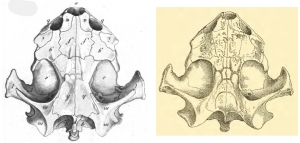
Cuvier’s skull drawing (left) compared to Boulengers 1891 (right) drawing of the Chelys boulengeri skull.
After all of these attempts to name this species it was clear there were some issues and this was going to require some attention. So in 1960 Mertens and Wermuth in Case 1459 (to old to look up on the ICZN site) apart from other housekeeping of names they also requested that Fermin’s name Testudo terrestris be overturned to conserve stability. This was responded to by Holthius (1960) that Fermin’s work was not entirely binomial and hence could be placed on the List of Rejected Works in Zoology. The ICZN handed down their decision (Opinion 660) in 1963 which on this issue agreed with Holthius and the entire work of Fermin was basically declared unavailable for nomenclature. This freed up the name Testudo terrestris (as a subspecies of Testudo graeca) for the Spur-Thighed Tortoise and maintained Testudo fimbriata for the Matamata. Hence stability of nomenclature was maintained.
That is the complete story of the naming of the Matamata in an effort that lasted 270 years from start to finish.

